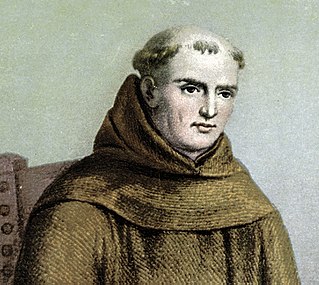
Saint Junípero Serra Ferrer, popularly known simply as Junipero Serra, was a Spanish Catholic priest and missionary of the Franciscan Order. He is credited with establishing the Franciscan Missions in the Sierra Gorda, a UNESCO World Heritage Site. He founded a mission in Baja California and established eight of the 21 Spanish missions in California from San Diego to San Francisco, in what was then Spanish-occupied Alta California in the Province of Las Californias, New Spain.
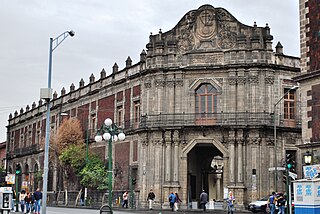
The Mexican Inquisition was an extension of the Spanish Inquisition into New Spain. The Spanish conquest of the Aztec Empire was not only a political event for the Spanish, but a religious event as well. In the early 16th century, the Reformation, the Counter-Reformation, and the Inquisition were in full force in most of Europe. The Catholic Monarchs of Castile and Aragon had just conquered the last Muslim stronghold in the Iberian Peninsula, the kingdom of Granada, giving them special status within the Catholic realm, including great liberties in the conversion of the native peoples of Mesoamerica. When the Inquisition was brought to the New World, it was employed for many of the same reasons and against the same social groups as suffered in Europe itself, minus the Indigenous to a large extent. Almost all of the events associated with the official establishment of the Palace of the Inquisition occurred in Mexico City, where the Holy Office had its own major building. The official period of the Inquisition lasted from 1571 to 1820, with an unknown number of individuals prosecuted.
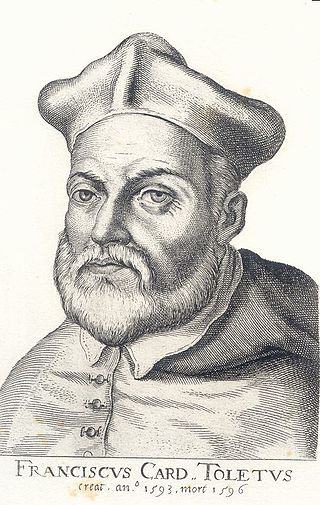
Francisco de Toledo was a Spanish Jesuit priest and theologian, Biblical exegete and professor at the Roman College. He is the first Jesuit to have been made a cardinal.

The Diocese of Teruel and Albarracín is a Latin diocese of the Catholic Church located in north-eastern Spain, in the province of Teruel, part of the autonomous community of Aragón. The diocese forms part of the ecclesiastical province of Zaragoza, thus suffragan to the Archdiocese of Zaragoza. In 1912, the diocese of Teruel comprised the civil province of the same name, excepting the town of Bechi (Castellón).
Diego José Abad y García was a Jesuit poet and translator in New Spain and Italy.
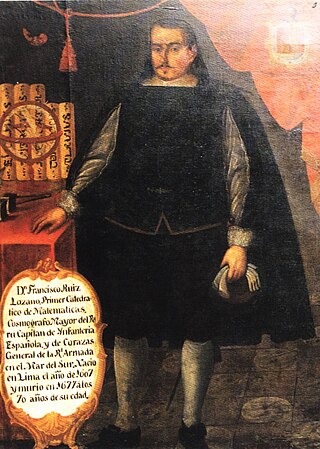
Francisco Ruiz Lozano was a Peruvian soldier, astronomer, mathematician and educator.

Diego José de Cádiz (1743–1801) was a Spanish Capuchin friar who was a noted and popular preacher throughout the region of Andalusia during the 18th century. He was beatified by the Catholic Church in 1894.
Agustín de Vetancurt was a Mexican Catholic historian and scholar of the Nahuatl language. Born in Mexico City, Vetancurt became a Franciscan in Puebla, where he spent 40 years amongst the indigenous. He was official chronicler of the Order, so much of his most important work Teatro Mexicano deals with matters of interest to its members. But it is not only a history of the Franciscans in Mexico, but also a wide-ranging discussion of indigenous history and customs, topics of great interest to Franciscans of the first generation in Mexico. He drew upon the works of fellow Franciscans Gerónimo de Mendieta and Juan de Torquemada. Although he recapitulates some material from his sources, there is considerable material on prehispanic and colonial indigenous not found elsewhere and particularly valuable for the seventeenth century. He was helped in his work by Don Carlos de Siguenza y Gongora, and it is possible that some information on prehispanic indigenous culture came from him. Vetancurt accused his Franciscan predecessor Fray Juan de Torquemada, author of Monarquia Indiana, of plagiarizing the work of Gerónimo de Mendieta.

Alberto del Canto, formally Alberto Vieira do Canto, was a noble and military Portuguese conquistador who explored the north of Mexico, where he was the founder of several cities.
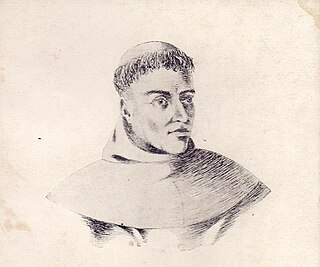
Alfonso de Castro, O.F.M., known also as Alphonsus à Castro, was a Franciscan theologian and jurist. He belongs to the group of theologian-jurists known as the School of Salamanca, though he denied belonging to a specific school of thought and condemned many theologians who did. He was most well-known in the sixteenth century for his work Adversus omnes haereses, libri XIV, an encyclopedic treatise on ancient and modern heresies.

Francisco de Ayeta was a Spanish Franciscan missionary of the 17th century, in New Spain.

Gaspar de Quiroga y Vela was a prominent Catholic official who rose to become General Inquisitor of Spain, from 1573 to 1594, and Archbishop of Toledo from 1577 to 1594. He was named a Cardinal by Pope Gregory XIII in 1578. He was the nephew of the 1st Bishop of Michoacán, Mexico, Vasco de Quiroga,.

Joseph Pérez was a French historian specializing in Spanish history. Pérez specialized in the births of the modern Spanish state and the Latin American nations. Among his books, he examined the independence movements of Hispanic America; Ferdinand and Isabella, the Catholic Monarchs; Holy Roman Emperor Charles V, and Philip II of Spain.
Miguel Juan de Plasencia was a Spanish friar of the Franciscan Order. He was among the first group of Franciscan missionaries who arrived in the Philippines on 2 July 1578.

Juan Diego Cuauhtlatoatzin, also known simply as Juan Diego, was a Chichimec peasant and Marian visionary. He is said to have been granted apparitions of Our Lady of Guadalupe on four occasions in December 1531: three at the hill of Tepeyac and a fourth before don Juan de Zumárraga, then bishop of Mexico. The Basilica of Our Lady of Guadalupe, located at the foot of Tepeyac, houses the cloak (tilmahtli) that is traditionally said to be Juan Diego's, and upon which the image of the Virgin is said to have been miraculously impressed as proof of the authenticity of the apparitions.

The National Shrine and Parish of St. Anthony of Padua, commonly known as the Church of Pila, is a Roman Catholic national shrine dedicated to Saint Anthony of Padua in the Philippines in 1578 and the first Antonine parish church in the Philippines in 1581 and probably in Asia. In 1606 the Franciscans set up the second printing press of the Philippines under the supervision of Tomás Pinpín and Domingo Loag. Its titular is Anthony of Padua, whose feast is celebrated every June 13.
Diego Pérez de Valdivia was a Spanish disciple of John of Ávila who wrote on lay spirituality.

Diego de Torre(s) y Moyachoque was cacique of Turmequé, in the New Kingdom of Granada. He served as chief from 1571 to his death. De Torres y Moyachoque was a mestizo, the child of a Spanish conquistador and a Muisca noble. He is known for his defense of the local Muisca and resistance against the Spanish encomenderos, particularly his half-brother Pedro de Torres. De Torres y Moyachoque is also known as the first cartographer of the lands surrounding the capital of the New Kingdom of Granada, Santa Fe de Bogotá.
Antonio de Ciudad Real was a Franciscan friar, born 1551, in Castilla La Nueva, Spain. At the age of 15, he joined the Convent of San Francisco, in Toledo, Spain. In 1573, he accompanied Diego de Landa, on his second trip to Yucatán, in the Viceroyalty of New Spain. Between 1584 and 1589, he accompanied Alonso Ponce, the commissary general of the Franciscan Order, on his trip from Mexico to Nicaragua, visiting the Franciscan convents of New Spain. A record of this long trip is contained in his work Tratado curioso y docto de las grandezas de la Nueva España. He was also the author of the 1577 Motul Dictionary, which translates words of Yucatec Maya into Spanish. In 1603 he was elected provincial of the Franciscan order. He died on July 5, 1617, in Mérida, Yucatán, Nueva España.
In the late 16th century, the Spanish Empire attempted to settle the Strait of Magellan with the aim of controlling the only known passage between the Atlantic and Pacific oceans at the time. The project was a direct response to Francis Drake's unexpected entry into the Pacific through the strait in 1578 and the subsequent havoc his men wreaked upon the Pacific coast of Spanish America. The colonization effort took the form of a naval expedition led by veteran explorer Pedro Sarmiento de Gamboa, which set sail from Cádiz in December 1581. The expedition established two short-lived settlements in the strait, Nombre de Jesús and Ciudad del Rey Don Felipe. However, the settlers proved poorly prepared for the cool and windy environment of the strait, and starvation and disease was soon rampant. A resupply expedition organized by Sarmiento in Río de Janeiro in 1585 was unable to reach the strait due to unfavorable weather. Aid to the struggling colony was later hampered by Sarmiento falling prisoner to English corsairs in 1586 and the unresponsivity of King Philip II, likely due to the strain of Spain's resources caused by the wars with England and Dutch rebels. The last known survivor was rescued by a passing ship in 1590.














